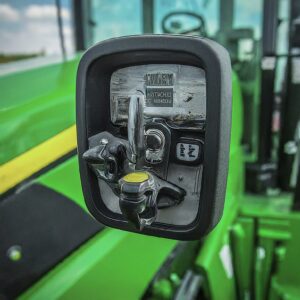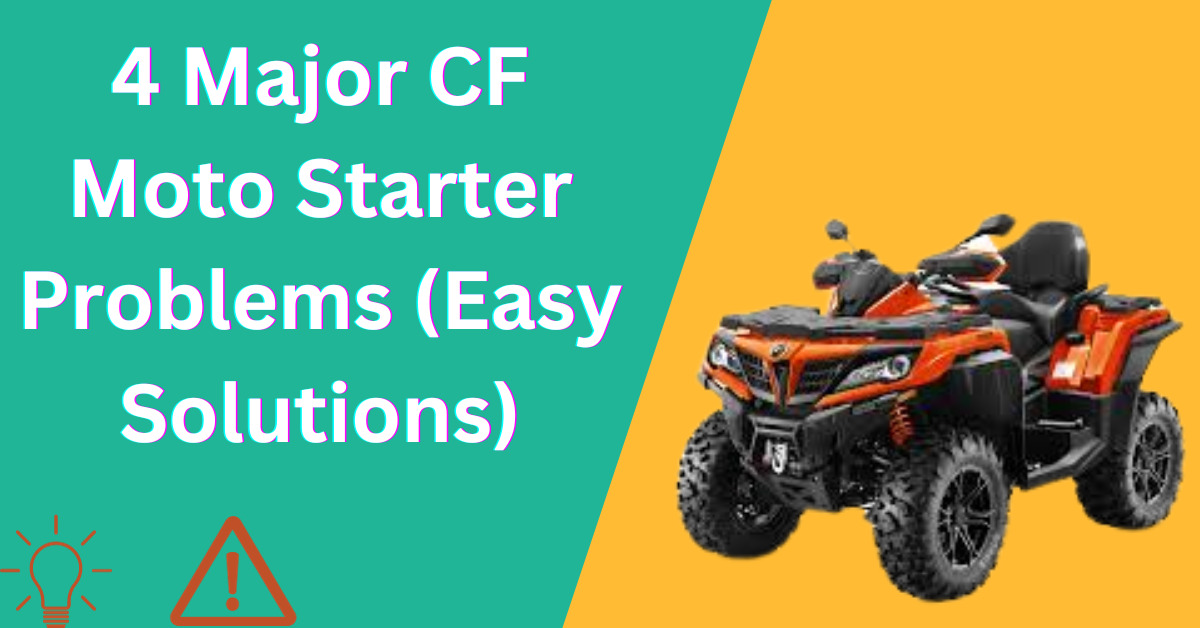When it comes to hitting the open road on your CF Moto, encountering starter problems can be frustrating. Whether you’re a seasoned rider or a newcomer to the world of ATVs, dealing with a faulty starter can put a damper on your adventures.
In this guide, we’ll delve into the various CF Moto starter problems that riders might face, offering insights, tips, and solutions to ensure you’re back on the trails without a hitch.
The 4 major CF Moto starting Issues are Starter Clicks But Doesn’t Engage, Engine Cranks Slowly, Engine Doesn’t Crank at All, and Frequent Starter Burnouts.
5 Major CF Moto Starter Problems
The starting problems of Cf Moto can range from minor inconveniences to more complex issues. Let’s explore some common problems you might encounter:
1. Starter Clicks But Doesn’t Engage

One of the frustrating situations riders face is when they hear a clicking sound when attempting to start the CF Moto, but the engine doesn’t engage. This issue could be due to a weak battery, corroded terminals, or a faulty starter solenoid.
- Weak Battery: One common reason for a clicking sound without engagement is a weak or discharged battery. The clicking noise you hear is the starter solenoid trying to engage, but it doesn’t have enough power to turn the engine over. Try charging the battery or jump-starting the CF Moto to see if that resolves the issue.
- Faulty Starter Solenoid: The starter solenoid is responsible for sending power from the battery to the starter motor. If it’s faulty or worn out, it may click but fail to engage the starter motor. Inspect the solenoid for any signs of damage or wear and consider replacing it if necessary.
- Starter Motor Issues: If the starter motor itself is faulty or damaged, it may not engage properly when you try to start the CF Moto. Listen for any unusual noises coming from the starter motor when you attempt to start the vehicle. If you hear grinding or whining sounds, it could indicate a problem with the starter motor.
- Starter Relay Problems: The starter relay is another component that can cause clicking sounds without engagement. Check the relay for any signs of damage or corrosion and replace it if needed.
- Ignition Switch Malfunction: In some cases, the issue may be related to the ignition switch. If the switch is faulty or worn out, it may not send the proper signal to engage the starter motor. Consider testing the ignition switch or having it inspected by a professional mechanic.
- Wiring Issues: Faulty wiring or connections can also prevent the starter system from engaging properly. Inspect the wiring harness, connectors, and terminals for any signs of damage or corrosion. Clean all connections and make sure that they are secure.
- Engine Seized: In rare cases, a seized engine could prevent the starter motor from engaging. This usually occurs due to internal engine damage or lack of lubrication. If you suspect the engine is seized, it’s best to have it inspected by a qualified mechanic.
2. Engine Cranks Slowly
If the engine cranks slowly when starting, it could indicate an issue with the battery, starter motor, or wiring connections.
- Weak Battery: One common reason for slow cranking is a weak or discharged battery. Over time, batteries can lose their charge, especially if the vehicle is not used frequently or if there’s a parasitic drain. Start by checking the battery voltage with a multimeter. If it’s below the recommended level, consider charging or replacing the battery.
- Corroded Battery Terminals: Corrosion on the battery terminals can hinder the flow of electricity, leading to slow cranking. Inspect the battery terminals for any signs of corrosion, such as white powdery residue. Clean the terminals using a wire brush and a mixture of baking soda and water to ensure a good connection.
- Faulty Starter Motor: A malfunctioning starter motor can also cause slow cranking. Listen for any unusual noises, such as grinding or clicking, when you attempt to start the engine. If you suspect the starter motor is the culprit, have it inspected by a qualified mechanic and replaced if necessary.
- Poor Ground Connections: Inadequate grounding can prevent the starter motor from receiving sufficient power, resulting in slow cranking. Check the ground connections between the battery, starter motor, and chassis for tightness and corrosion. Clean and tighten any loose connections to improve electrical conductivity.
- Low Engine Oil Level: Insufficient lubrication can increase friction within the engine, making it harder to crank over. Check the engine oil level using the dipstick and top it up if necessary. Additionally, inspect the oil for any signs of contamination or degradation, which may indicate underlying issues with the engine.
- Cold Weather Conditions: Cold temperatures can cause engine oil to thicken, making it more difficult for the engine to turn over. Consider using a thinner viscosity oil or installing a block heater to improve cold starting performance in winter.
- Fuel Delivery Issues: If the engine is not receiving an adequate supply of fuel, it may struggle to crank over. Check the fuel pump, fuel filter, and fuel lines for any obstructions or leaks. Make sure the fuel tank is sufficiently filled and that the fuel is clean and free of contaminants.
- Ignition System Problems: Faulty ignition components, such as spark plugs, ignition coils, or the ignition switch, can prevent the engine from starting smoothly. Inspect the ignition system for any signs of wear or damage and replace any faulty components as needed.
3. The Engine Doesn’t Crank at All
When the engine doesn’t crank at all, it’s essential to identify the root cause, which could be a faulty starter switch, damaged ignition system, or electrical issues.
- Dead Battery: One common reason for an engine not cranking is a dead or low battery. Check the battery terminals to ensure they are clean and securely connected. If the battery is old or discharged, try jump-starting the engine or replacing the battery with a new one.
- Faulty Starter Motor: If the battery is fully charged but the engine still doesn’t crank, the starter motor might be faulty. Listen for any clicking noises when you turn the ignition key, as this could indicate a problem with the starter motor. If you suspect a faulty starter motor, it may need to be replaced by a qualified mechanic.
- Ignition Switch Issues: A faulty ignition switch can prevent power from reaching the starter motor, causing the engine not to crank. Check the ignition switch for any signs of damage or wear, and consider having it inspected and replaced if necessary.
- Starter Solenoid Problems: The starter solenoid is responsible for engaging the starter motor when you turn the ignition key. If the solenoid is faulty or worn out, it may prevent the engine from cranking. Inspect the solenoid for any signs of damage or corrosion, and replace it if needed.
- Fuel System Issues: In some cases, a problem with the fuel system, such as a clogged fuel filter or a faulty fuel pump, can prevent the engine from cranking. Check the fuel system components for any issues and address them accordingly.
- Electrical Wiring Problems: Faulty or damaged electrical wiring can also cause the engine not to crank. Inspect the wiring harness for any signs of damage or loose connections, and repair or replace any damaged wires as needed.
- Engine Seized: In rare cases, an engine may seize due to a lack of lubrication or other mechanical issues. If the engine is seized, it will not crank at all, and professional assistance will be required to diagnose and repair the problem.
4. Frequent Starter Burnouts
Frequent starter burnouts can occur due to various factors, including overheating, electrical issues, or using low-quality components.
- Check Battery Health: Start by checking the health of your CF Moto’s battery. A weak or worn-out battery can put extra strain on the starter motor, leading to burnouts. Be sure to keep the battery terminals clean and secure. If the battery is old or showing signs of weakness, consider replacing it with a new one.
- Inspect Starter Motor: Examine the starter motor for any signs of damage or wear. Look for frayed wires, loose connections, or worn-out components that may be causing the burnouts. If you notice any issues, it’s best to have the starter motor inspected and repaired by a qualified technician.
- Avoid Over-Cranking: Avoid excessive cranking of the engine, as this can put undue stress on the starter motor and lead to burnout. If your CF Moto is taking longer than usual to start, investigate the underlying cause rather than repeatedly trying to start it.
- Check Ignition System: A faulty ignition system can also contribute to starter burnouts. Check the ignition switch, ignition coil, and spark plugs for any signs of malfunction. Replace any worn-out or damaged components to ensure proper ignition and prevent strain on the starter motor.
- Ensure Proper Maintenance: Regular maintenance is crucial for preventing starter burnouts and other mechanical issues. Follow the manufacturer’s recommended maintenance schedule for your CF Moto, including oil changes, filter replacements, and overall inspections. Proper maintenance can help identify and address potential problems before they escalate.
5. Noisy Starter
Unusual noises during startup could indicate damaged gears or a loose starter motor. Here are a few problems of noisy starters.
1. Worn Out Starter Motor
One of the primary reasons for a noisy starter in CF Moto is a worn-out starter motor. Over time, the internal components of the starter motor can become damaged or worn, leading to a grinding or whining noise when starting the vehicle. If you notice a loud noise coming from the starter area, the starter motor likely needs to be replaced.
To fix this issue, you should consult a professional mechanic or authorized CF Moto service center. They will be able to diagnose the problem accurately and replace the faulty starter motor with a new one. The electrical system of the vehicle needs to be addressed promptly to avoid further damage.
2. Loose or Damaged Starter Solenoid
Another potential cause of noisy starter issues in CF Moto is a loose or damaged starter solenoid. When you turn the ignition key, the starter solenoid engages the starter motor. If the solenoid is loose or damaged, it may produce a clicking or buzzing noise when starting the vehicle.
To resolve this problem, you can start by checking the connections of the starter solenoid. Ensure that all the wires are securely connected and that there are no signs of corrosion or damage. If you find any loose connections or damaged wires, they should be repaired or replaced accordingly. If the solenoid itself is faulty, it may need to be replaced by a professional.
3. Low Battery Voltage
A low battery voltage can also contribute to noisy starter issues in CF Moto. When the battery does not have enough power, the starter motor may struggle to engage, resulting in a clicking or grinding noise. This problem is more likely to occur in older batteries or in vehicles that have been sitting idle for an extended period.
If you suspect that a low battery voltage is causing the noisy starter problem, you can try jump-starting the vehicle using jumper cables and a second vehicle with a fully charged battery. If the noise disappears after jump-starting, it indicates that the battery needs to be replaced. Consider purchasing a new battery from a reputable supplier to ensure optimal performance.
By following these steps, you can easily get rid of CF Moto starting problems.
DIY Troubleshooting Tips for Cf Moto Starting Problems
If you encounter any of these starter problems, here are some DIY troubleshooting steps you can take:
- Check the Battery: Ensure that your CF Moto’s battery is fully charged and in good condition. Weak batteries can often mimic starter issues.
- Inspect Wiring: Examine the wiring connections to the starter system. Loose or corroded wires can disrupt the electrical flow.
- Clean Terminals: Regularly clean the battery terminals to prevent corrosion, which can impede the electrical connection.
- Test the Solenoid: Use a multimeter to test the starter solenoid’s functionality. Replace it if it fails the test.
Conclusion
Facing CF Moto starter problems can be a hassle, but with the right knowledge and troubleshooting steps, you can overcome these challenges and get back to enjoying your rides with confidence. By identifying the issues, following the solutions provided, and conducting regular maintenance, you’ll ensure that your CF Moto starts reliably and smoothly each time.
FAQs
Why is my CF Moto making a clicking noise when I try to start it?
If your CF Moto is making a clicking noise but not starting, it’s likely due to a weak battery or a faulty starter solenoid. Check the battery voltage and connections, and consider testing or replacing the starter solenoid.
What should I do if my CF Moto’s starter motor is cranking slowly?
A slow-cranking starter motor could indicate battery issues or a worn-out starter motor. Test the battery’s voltage and connections, and if needed, replace the battery or the starter motor.
How can I diagnose the cause of my CF Moto’s starter problems?
To diagnose CF Moto starter problems, start by checking the battery, terminals, and connections. Test the starter switch, inspect the ignition system, and examine the wiring for any damage. This step-by-step approach can help pinpoint the root cause.
Can I replace the starter solenoid myself?
Yes, replacing the starter solenoid is a task that many riders can handle themselves. However, if you’re not comfortable with DIY repairs, it’s recommended to seek professional assistance to ensure proper installation.
What precautions can I take to prevent starter burnouts in my CF Moto?
To prevent starter burnouts, ensure proper ventilation around the starter to prevent overheating. Additionally, use high-quality starters and components and regularly inspect the electrical connections and wiring for any issues.
My CF Moto’s engine doesn’t crank at all—what could be the problem?
If your CF Moto’s engine doesn’t crank at all, it could be due to a faulty starter switch, damaged ignition system, or electrical problems. Test the starter switch, inspect the ignition components, and check the fuses and relays related to the starting system.








